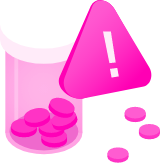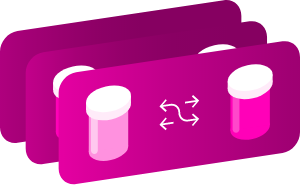This drug entry is astuband has not been fully annotated. It is scheduled to be annotated soon.
Identification
- Generic Name
- Dithiazanine
- DrugBank Accession Number
- DB11516
- Background
-
Dithiazanine is a highly potent anthelmintic, introduced in 1959 for the treatment of strongyloid worms and whipworms. However, its use is severely limited due to its toxicity. Dithiazanine iodide was associated with eight fatal cases of severe acidosis and shock between 1961 and 1964. Dithiazanine iodide has been withdrawn from the market in countries such as France in Italy, but it may remain available in others.11,12
- Type
- Small Molecule
- Groups
- Vet approved, Withdrawn
- Structure
- Weight
-
Average: 391.57
Monoisotopic: 391.129717517 - Chemical Formula
- C23H23N2S2
- Synonyms
-
- 3,3'-Diethylthiadicarbocyanine
- Dithiazaninum
Pharmacology
- Indication
-
Not Available
 Reduce drug development failure ratesBuild, train, & validate machine-learning models
Reduce drug development failure ratesBuild, train, & validate machine-learning models
with evidence-based and structured datasets.Build, train, & validate predictive machine-learning models with structured datasets. - Contraindications & Blackbox Warnings
-
 Avoid life-threatening adverse drug eventsImprove clinical decision support with information oncontraindications & blackbox warnings, population restrictions, harmful risks, & more.Avoid life-threatening adverse drug events & improve clinical decision support.
Avoid life-threatening adverse drug eventsImprove clinical decision support with information oncontraindications & blackbox warnings, population restrictions, harmful risks, & more.Avoid life-threatening adverse drug events & improve clinical decision support. - Pharmacodynamics
-
Not Available
- Mechanism of action
- Not Available
- Absorption
-
Not Available
- Volume of distribution
-
Not Available
- Protein binding
-
Not Available
- Metabolism
- Not Available
- Route of elimination
-
Not Available
- Half-life
-
Not Available
- Clearance
-
Not Available
- Adverse Effects
-
 Improve decision support & research outcomesWith structured adverse effects data, including:blackbox warnings, adverse reactions, warning & precautions, & incidence rates.Improve decision support & research outcomes with our structured adverse effects data.
Improve decision support & research outcomesWith structured adverse effects data, including:blackbox warnings, adverse reactions, warning & precautions, & incidence rates.Improve decision support & research outcomes with our structured adverse effects data. - Toxicity
-
Not Available
- Pathways
- Not Available
- Pharmacogenomic Effects/ADRsBrowse all" title="" id="snp-actions-info" class="drug-info-popup" href="javascript:void(0);">
- Not Available
Interactions
- Drug InteractionsLearn More" title="" id="structured-interactions-info" class="drug-info-popup" href="javascript:void(0);">
-
This information should not be interpreted without the help of a healthcare provider. If you believe you are experiencing an interaction, contact a healthcare provider immediately. The absence of an interaction does not necessarily mean no interactions exist.Not Available
- Food Interactions
- Not Available
Products
-
 Drug product information from 10+ global regionsOur datasets provide approved product information including:
Drug product information from 10+ global regionsOur datasets provide approved product information including:
dosage, form, labeller, route of administration, and marketing period.Access drug product information from over 10 global regions. - Product Ingredients
-
Ingredient UNII CAS InChI Key Dithiazanine iodide 8OEC3RA07X 514-73-8 MNQDKWZEUULFPX-UHFFFAOYSA-M
Categories
- Drug Categories
-
- Anthelmintics
- Anti-Infective Agents
- Antinematodal Agents
- Antiparasitic Agents
- Benzothiazoles
- Coloring Agents
- Compounds used in a research, industrial, or household setting
- Fluorescent Dyes
- Heterocyclic Compounds, Fused-Ring
- Indicators and Reagents
- Laboratory Chemicals
- Luminescent Agents
- Sulfur Compounds
- Thiazoles
- Chemical TaxonomyProvided byClassyfire
-
- Description
- This compound belongs to the class of organic compounds known as benzothiazoles. These are organic compounds containing a benzene fused to a thiazole ring (a five-membered ring with four carbon atoms, one nitrogen atom and one sulfur atom).
- Kingdom
- Organic compounds
- Super Class
- Organoheterocyclic compounds
- Class
- Benzothiazoles
- Sub Class
- Not Available
- Direct Parent
- Benzothiazoles
- Alternative Parents
- Aryl thioethers/Benzenoids/Thiazoles/Heteroaromatic compounds/Ketene acetals/Azacyclic compounds/Organopnictogen compounds/Organonitrogen compounds/Hydrocarbon derivatives/Organic cations
- Substituents
- 1,2-benzothiazole/1,3-benzothiazole/Aromatic heteropolycyclic compound/Aryl thioether/Azacycle/Azole/Benzenoid/Benzo-thiazole/Heteroaromatic compound/Hydrocarbon derivative
- Molecular Framework
- Aromatic heteropolycyclic compounds
- External Descriptors
- benzothiazoles, benzothiazolium ion (CHEBI:52787)
- Affected organisms
- Not Available
Chemical Identifiers
- UNII
- 5L7E7IY5EH
- CAS number
- 7187-55-5
- InChI Key
- FYXWDSGGZAMYFZ-UHFFFAOYSA-N
- InChI
-
InChI=1S/C23H23N2S2/c1-3-24-18-12-8-10-14-20(18)26-22(24)16-6-5-7-17-23-25(4-2)19-13-9-11-15-21(19)27-23/h5-17H,3-4H2,1-2H3/q+1
- IUPAC Name
-
3-ethyl-2-[5-(3-ethyl-2,3-dihydro-1,3-benzothiazol-2-ylidene)penta-1,3-dien-1-yl]-1,3-benzothiazol-3-ium
- SMILES
-
[H]C(C([H])=C([H])C1=[N+](CC)C2=CC=CC=C2S1)=C([H])C([H])=C1SC2=C(C=CC=C2)N1CC
References
- 一般引用
-
- GARAGUSO P: [Dithiazanine and Hymenolepis nana]. Sem Med. 1962 Jan 4;120:53-60. [Article]
- VINKE B, van der SAR: Dithiazanine, a new anthelminthic. Trop Geogr Med. 1959 Dec;11:335-8. [Article]
- CERF J: [Dithiazanine therapy of strongyloidosis]. Ann Soc Belg Med Trop (1920). 1958 Dec 31;38(6):1027-30. [Article]
- GARAGUSO P: [Dithiazanine and Enterobius vermicularis]. Sem Med. 1961 Nov 23;119:1803-14. [Article]
- GARAGUSO P: [Dithiazanine and Ancylostoma or Necator]. Sem Med. 1961 Dec 11;119:2016-21. [Article]
- strongyl MUHLEISEN JP, SWARTZWELDER JC:治疗oidiasis with dithiazanine. Am J Gastroenterol. 1959 Sep;32:317-27. [Article]
- BASNUEVO JG, KOURI A: [Anthelmintic action of dithiazanine iodide]. Rev Kuba Med Trop Parasitol. 1959 Jul-Dec;15:27-36. [Article]
- MILLER JH, ANTHONY SO, SWARTZWELDER JC, FRYE WW, LAMPERT R: Treatment of enterobiasis with dithiazanine. Am J Dig Dis. 1958 Mar;3(3):229-31. [Article]
- LIMA JP, PALOMBINI BC, TANNHAUSER SL: [Dithiazanine in treatment of strongyloidiasis]. Rev Bras Med. 1960 Feb;17:123-6. [Article]
- RODRIGUEZDECURET H, DELPILARALIAGA M: DITHIAZANINE INTOXICATION, A CASE REPORT. Bol Asoc Med P R. 1963 Nov;55:469-73. [Article]
- Garmaise DL, Chambers CH, Komlossy J, McCrae RC: Anthelmintic quaternary salts. Thiacyanines and hemithiacyanines. J Med Chem. 1967 Sep;10(5):897-9. doi: 10.1021/jm00317a031. [Article]
- WHO: Consolidated list of products whose consumption and/or sale have been banned, withdrawn, severely restricted or not approved by governments [Link]
- External Links
-
- ChemSpider
- 10134
- BindingDB
- 47714
- ChEBI
- 52787
- ChEMBL
- CHEMBL1185568
- ZINC
- ZINC000001628132
Clinical Trials
- Clinical TrialsLearn More" title="" id="clinical-trials-info" class="drug-info-popup" href="javascript:void(0);">
-
Phase Status Purpose Conditions Count
Pharmacoeconomics
- Manufacturers
-
Not Available
- Packagers
-
Not Available
- Dosage Forms
- Not Available
- Prices
- Not Available
- Patents
- Not Available
Properties
- State
- Not Available
- Experimental Properties
- Not Available
- Predicted Properties
-
Property Value Source Water Solubility 0.00028 mg/mL ALOGPS logP 2.42 ALOGPS logP 2.52 Chemaxon logS -6.2 ALOGPS pKa (Strongest Basic) -2 Chemaxon Physiological Charge 1 Chemaxon Hydrogen Acceptor Count 1 Chemaxon Hydrogen Donor Count 0 Chemaxon Polar Surface Area 7.12 Å2 Chemaxon Rotatable Bond Count 5 Chemaxon Refractivity 142.44 m3·mol-1 Chemaxon Polarizability 45.11 Å3 Chemaxon Number of Rings 4 Chemaxon Bioavailability 1 Chemaxon Rule of Five Yes Chemaxon Ghose Filter No Chemaxon Veber's Rule Yes Chemaxon 医学博士DR-like Rule No Chemaxon - Predicted ADMET Features
- Not Available
Spectra
- Mass Spec (NIST)
- Not Available
- Spectra
-
Spectrum Spectrum Type Splash Key Predicted MS/MS Spectrum - 10V, Positive (Annotated) Predicted LC-MS/MS Not Available Predicted MS/MS Spectrum - 20V, Positive (Annotated) Predicted LC-MS/MS Not Available Predicted MS/MS Spectrum - 40V, Positive (Annotated) Predicted LC-MS/MS Not Available Predicted MS/MS Spectrum - 10V, Negative (Annotated) Predicted LC-MS/MS Not Available Predicted MS/MS Spectrum - 20V, Negative (Annotated) Predicted LC-MS/MS Not Available Predicted MS/MS Spectrum - 40V, Negative (Annotated) Predicted LC-MS/MS Not Available
Drug created at February 26, 2016 17:31 / Updated at November 18, 2022 07:07




